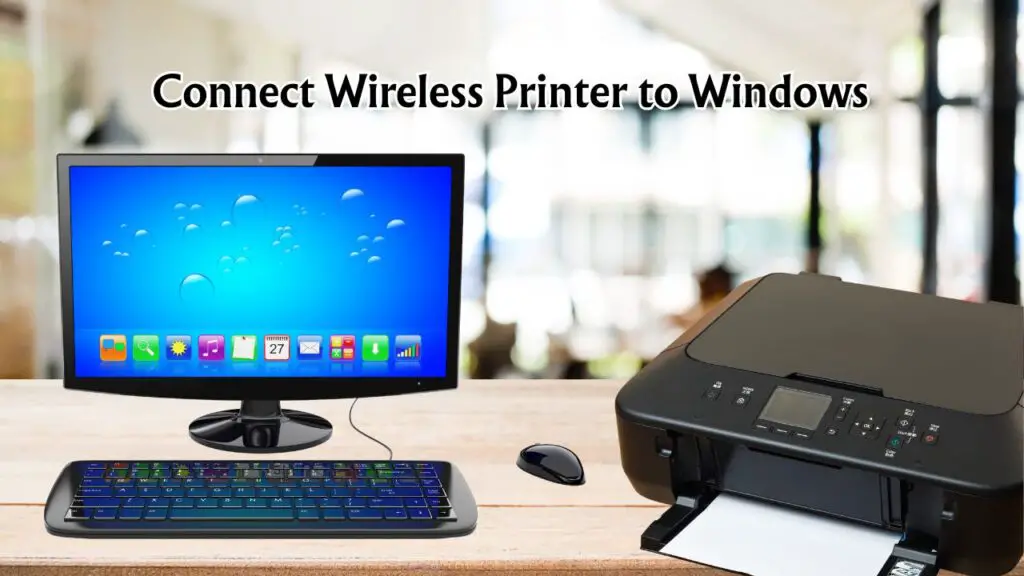Setting up a wireless printer on your Windows 11 or Windows 10 PC can feel complicated at first, but the process is actually straightforward if you follow the right steps. A wireless printer gives you the flexibility to print without being tethered by cables, and once connected, it can be accessed by multiple devices on the same network.
This guide will walk you through every step, from connecting your printer to Wi-Fi to troubleshooting common issues.
How to connect a wireless printer easily to Windows 11 or 10?

The process of connecting your wireless printer involves a few important steps:
Step 1: Connecting the printer to the Wi-Fi network
Step 2: Adding the printer or scanner to Windows
Step 3: Installing the Printer Software
Step 4: Changing the default printer
Step 5: Troubleshooting the Printer.
Let’s go through them in order.
Step 1: Connecting the printer to the Wi-Fi network
Before Windows can recognize your printer, you must first connect the printer itself to your wireless network. Most modern printers come with a built-in display panel that allows you to select your Wi-Fi network and enter the password.
- Power on your wireless printer and ensure it is placed within range of your Wi-Fi router.
- Use the printer’s built-in display panel or buttons to open its Wireless Setup Wizard.
- From the available Wi-Fi networks, select your home or office Wi-Fi network.
- Enter your Wi-Fi password carefully and confirm the connection.
- Once connected, you will usually see a confirmation message on the printer’s screen.
Your printer is now linked to the Wi-Fi network, making it ready to be added to Windows.
Step 2: Adding the printer or scanner to Windows
Now that your printer is connected to Wi-Fi, the next step is to add it to Windows 11 or Windows 10.
- On your computer, press Windows + I to open Settings.
- Navigate to Devices and then select Printers & scanners.
- Click on Add a printer or scanner.
- Windows will start searching for available printers on the same Wi-Fi network.
- Once your printer appears in the list, select it and click Add device.
If your printer does not appear, check whether it is connected to the correct Wi-Fi network. You may also need to temporarily disable your firewall to see if it is blocking the connection.
Step 3: Installing the Printer Software
While Windows often installs the necessary drivers automatically, it is recommended to install the official software from your printer manufacturer. This ensures you get access to advanced features such as scanning, ink level monitoring, and troubleshooting tools.
For example, if you are setting up an HP wireless printer, you can download the HP Smart app or the official driver package from HP’s website.
Similarly, if you own an Epson or Canon printer, you can find their software on their respective support websites.
Once downloaded, run the installer and follow the on-screen instructions to complete the setup.
Step 4: Changing the default printer
If you have multiple printers installed on your PC, you might want to set your wireless printer as the default one.
- Go to Settings > Devices > Printers & scanners.
- Select your wireless printer from the list.
- Click on Manage, and then select Set as default.
This ensures that your wireless printer will always be the first option when you try to print a document.
Step 5: Troubleshooting the Printer
Even with a proper setup, wireless printers can sometimes face issues. Here are a few common troubleshooting steps you can try:
- Restart both your printer and your Windows PC.
- Ensure that your printer is connected to the same Wi-Fi network as your computer.
- Run the built-in Windows Printer Troubleshooter. You can access it by going to Settings > Update & Security > Troubleshoot.
- Reinstall your printer software if the problem persists.
- Check if there are any firmware updates available for your printer on the manufacturer’s website.
Fix “Can’t find your printer” Error
If Windows cannot detect your printer during the setup process, try these additional steps:
- Make sure your printer is powered on and the Wi-Fi connection is active.
- Confirm that your PC and printer are on the same wireless network.
- Click on the printer that I want isn’t listed when Windows fails to find it. From here, you can manually add the printer by entering its IP address.
- Reset the printer’s network settings and reconnect it to Wi-Fi. This often helps if the printer was connected to a different network before.
- Temporarily disable any third-party antivirus or firewall software, as they may block the printer connection.
Following these steps should resolve the “Can’t find your printer” error and allow Windows to properly detect your device.
How to Optimize Your Experience with a Wireless Printer?
Once your printer is successfully connected, you can improve your printing experience by making a few adjustments.
Always ensure your printer has the latest firmware and drivers installed, as updates often bring performance improvements and bug fixes.
It is also a good idea to keep your printer close to your Wi-Fi router to minimize connectivity issues.
If you share your printer with multiple users, make sure it is set as the default printer on all connected PCs to avoid confusion.
You can also explore additional features such as cloud printing, which allows you to print documents directly from mobile devices or remote locations.
By keeping your software updated and managing your settings wisely, you can enjoy a smooth and efficient wireless printing experience on both Windows 11 and Windows 10.